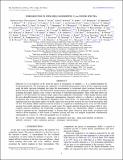FOREGROUNDS IN WIDE-FIELD REDSHIFTED 21 cm POWER SPECTRA
Author(s)
Cappallo, Roger J.; Corey, Brian E.; de Oliveira-Costa, Angelica; Dillon, Joshua Shane; Ewall-Wice, Aaron Michael; Feng, L.; Goeke, Robert F.; Hewitt, Jacqueline N.; Kratzenberg, Eric W.; Lonsdale, Colin John; McWhirter, Stephen R.; Morgan, Edward H.; Neben, Abraham Richard; Rogers, Alan E. E.; Tegmark, Max Erik; Whitney, Alan R.; Williams, Christopher Leigh; ... Show more Show less
DownloadThyagarajan-2015-Foregrounds in wide-.pdf (2.748Mb)
PUBLISHER_POLICY
Publisher Policy
Article is made available in accordance with the publisher's policy and may be subject to US copyright law. Please refer to the publisher's site for terms of use.
Terms of use
Metadata
Show full item recordAbstract
Detection of 21 cm emission of H i from the epoch of reionization, at redshifts z > 6, is limited primarily by foreground emission. We investigate the signatures of wide-field measurements and an all-sky foreground model using the delay spectrum technique that maps the measurements to foreground object locations through signal delays between antenna pairs. We demonstrate interferometric measurements are inherently sensitive to all scales, including the largest angular scales, owing to the nature of wide-field measurements. These wide-field effects are generic to all observations but antenna shapes impact their amplitudes substantially. A dish-shaped antenna yields the most desirable features from a foreground contamination viewpoint, relative to a dipole or a phased array. Comparing data from recent Murchison Widefield Array observations, we demonstrate that the foreground signatures that have the largest impact on the H i signal arise from power received far away from the primary field of view. We identify diffuse emission near the horizon as a significant contributing factor, even on wide antenna spacings that usually represent structures on small scales. For signals entering through the primary field of view, compact emission dominates the foreground contamination. These two mechanisms imprint a characteristic pitchfork signature on the "foreground wedge" in Fourier delay space. Based on these results, we propose that selective down-weighting of data based on antenna spacing and time can mitigate foreground contamination substantially by a factor of ~100 with negligible loss of sensitivity.
Date issued
2015-04Department
Haystack Observatory; Massachusetts Institute of Technology. Department of Physics; MIT Kavli Institute for Astrophysics and Space ResearchJournal
The Astrophysical Journal
Publisher
IOP Publishing
Citation
Thyagarajan, Nithyanandan, Daniel C. Jacobs, Judd D. Bowman, N. Barry, A. P. Beardsley, G. Bernardi, F. Briggs, et al. “FOREGROUNDS IN WIDE-FIELD REDSHIFTED 21 Cm POWER SPECTRA.” The Astrophysical Journal 804, no. 1 (April 24, 2015): 14. © 2015 The American Astronomical Society
Version: Final published version
ISSN
1538-4357